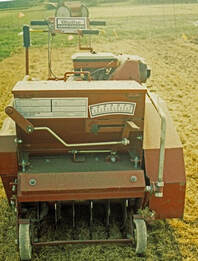 The keys to successful lawn seeding are proper rates, even dispersal, good seed to soil contact, and proper watering. Evenness is best achieved by carefully calibrating the seeder or by adjusting the seeder to a low setting and making several passes to ensure even distribution. Seeding a little on the heavy side with close overlapping is better than missing areas altogether, especially for the bunch-type tall fescue, which does not spread. Multiple seeder passes in opposite directions should help avoid this problem. A more serious error in seeding is using the improper rate. For tall fescue, aim for 6 to 8 pounds of seed per 1,000 square feet for new areas and about half as much for overseeding or seeding areas in the shade. Kentucky bluegrass is much smaller seed so less is needed for establishment. Use 2 to 3 pounds of seed per 1,000 square feet for a new lawn and half that for overseeding or shady areas. Using too much seed results in a lawn more prone to disease and damage from stress. The best way to avoid such a mistake is to determine the square footage of the yard first, and then calculate the amount of seed. Using too little seed can also be detrimental and result in clumpy turf that is not as visually pleasing. Establishing good seed to soil contact is essential for good germination rates. Slit seeders achieve good contact at the time of seeding by dropping seed directly behind the blade that slices a furrow into the soil. Packing wheels then follow to close the furrow. The same result can be accomplished by using a verticut before broadcasting the seed, and then verticutting a second time. Core aerators can also be used to seed grass. Go over an area at least three times in different directions, and then broadcast the seed. Germination will occur in the aeration holes. Because those holes stay moister than a traditional seedbed, this method requires less watering. If the soil that has been worked by a rototiller, firm the soil with a roller or lawn tractor and use light hand raking to mix the seed into the soil. A leaf rake often works better than a garden rake because it mixes seed more shallowly. Water newly planted areas lightly, but often. Keep soil constantly moist but not waterlogged. During hot days, a new lawn may need to be watered three times a day. If watered less, germination will be slowed. Cool, calm days may require watering only every couple of days. As the grass plants come up, gradually decrease watering to once a week if there is no rain. Let the plants tell you when to water. If you can push the blades down and they don't spring back up quickly, the lawn needs water. Once seed sprouts, try to minimize traffic (foot, mower, dog, etc.) seeded areas receive until the seedlings are a little more robust and ready to be mowed. Begin mowing once seedlings reach 3 to 4 inches tall. (Ward Upham) 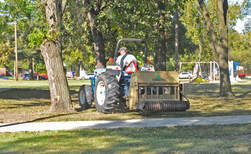 Tall fescue lawns that have become thin over the summer can be thickened up by overseeding during September. Start by mowing the grass short (1 to 1.5 inches) and removing the clippings. This will make it easier to achieve good seed-soil contact and increase the amount of light that will reach the young seedlings. Good seed-soil contact is vital if the overseeding is to be successful. Excess thatch can prevent seed from reaching the soil and germinating. Normally we want 1/4 inch of thatch or less when overseeding. If the thatch layer is 3/4 inch or more, it is usually easiest to use a sod cutter to remove it and start over with a new lawn. A power rake can be used to reduce a thatch layer that is less than 3/4 inch but more than a quarter inch. Once thatch is under control, the soil should be prepared for the seed. This can be done in various ways. For small spots, a hand rake can be used to roughen up the soil before the seed is applied, A verticut machine has solid vertical blades that can be set to cut furrows in the soil. It is best to go two different directions with the machine. A slit seeder is a verticut machine with a seed hopper added so the soil prep and seeding operation are combined. Another option is to use a core aerator. The core aerator will punch holes in the soil and deposit the soil cores on the surface of the ground. Each hole produces an excellent environment for seed germination and growth. Make three to four passes with the core aerator to ensure enough holes for the seed. Using a core aerator has the additional benefit of reducing the amount of watering needed to get the seed germinated and growing. Aeration also increases the water infiltration rate, decreases compaction, and increases the amount of oxygen in the soil. Of the three methods, I prefer the slit seeder for obtaining good seed/soil contact. However, if watering is difficult, core aeration may be a better option. Regardless of method used, fertilizer should be applied at the rate suggested by a soil test, or a starter fertilizer should be used at the rate suggested on the bag. (Ward Upham) 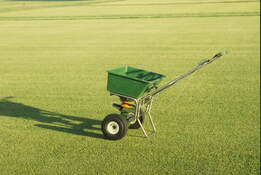 September is almost here and that means it is prime time to fertilize your tall fescue or Kentucky bluegrass lawns. If you could only fertilize your cool-season grasses once per year, this would be the best time to do it. These grasses are entering their fall growth cycle as days shorten and temperatures moderate (especially at night). Cool-season grasses naturally thicken up in the fall by tillering (forming new shoots at the base of existing plants) and, for bluegrass, spreading by underground stems called rhizomes. Consequently, September is the most important time to fertilize these grasses. Apply 1 to 1.5 pounds of actual nitrogen per 1,000 square feet. The settings recommended on lawn fertilizer bags usually result in about 1 pound of nitrogen per 1,000 square feet. We recommend a quick-release source of nitrogen at this time. Most fertilizers sold in garden centers and department stores contain either quick-release nitrogen or a mixture of quick- and slow-release. Usually only lawn fertilizers recommended for summer use contain slow-release nitrogen. Any of the others should be quick-release. The second most important fertilization of cool-season grasses also occurs during the fall. A November fertilizer application will help the grass green up earlier next spring and provide the nutrients needed until summer. It also should be quick-release applied at the rate of 1-pound actual nitrogen per 1,000 square feet. (Ward Upham) 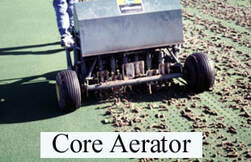 September is the optimum time to power rake or core-aerate tall fescue and Kentucky bluegrass lawns. These grasses should be coming out of their summer doldrums and beginning to grow more vigorously. This is a good time to consider what we are trying to accomplish with these practices. Power raking is primarily a thatch control operation. It can be excessively damaging to the turf if not done carefully. For lawns with one-half inch of thatch or less, I don’t recommend power raking but rather core aeration. For those who are unsure what thatch is, it is a springy layer of light-brown organic matter that resembles peat moss and is located above the soil but below the grass foliage. Power raking pulls up an incredible amount of material that then must be dealt with by composting or discarding. Core-aeration is a much better practice for most lawns. By removing cores of soil, core-aeration relieves compaction, hastens thatch decomposition, and improves water, nutrient, and oxygen movement into the soil profile. This operation should be performed when the soil is just moist enough so that it crumbles easily when worked between the fingers. Enough passes should be made so that the holes are spaced about 2 to 3 inches apart. Ideally, the holes should penetrate 2.5 to 3 inches deep. The cores can be left on the lawn to fall apart naturally (a process that usually takes two or three weeks, depending on soil-type), or they can be broken up with a power rake set just low enough to nick the cores, and then dragged with a section of chain-link fence or a steel doormat. The intermingling of soil and thatch is beneficial to the lawn. (Ward Upham) 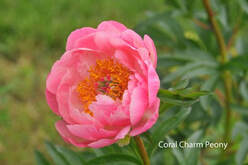 Peonies are a favorite perennial of gardeners because of their beauty and low maintenance. In Kansas, peonies provide a beautiful display of flowers each spring before Memorial Day. Though peonies can be left in place indefinitely, many gardeners wish to increase their plantings and use a process known as division to accomplish this. Keep in mind, however, that peonies often take about three years to return to full bloom and size after division. Fall is the traditional time to divide these plants. Peonies are essentially dormant by mid-August even though the foliage is still green. The first step in division is to remove the foliage. Then dig out the entire plant. Shake and wash off as much soil as possible so that the pink buds or "eyes" are visible. Peony roots are tough, and a sharp knife is needed to cut the roots into separate pieces. Make sure each division has three to four buds. Make sure the location chosen for planting receives at least a half-day of full sun. However, the more sun, the better. Space the plants so that there is at least 2 feet between dwarf types and 4 feet between the standard types. Follow the same rules for planting these divisions as you do for new plants. Make sure the pink buds are about 1 inch below the soil surface. If they are set more than 2 inches deep, flowering may be delayed or completely prevented. As you set the plants, firm soil often as it is added around the plant. If the soil is not firmed, it can settle and pull the plant down with it. Water in well after planting and water as necessary through the fall and winter to keep the soil moist. It is often a good idea to add mulch to the new planting to protect it from heaving. The alternate freezing and thawing that commonly occurs during Kansas winters can "heave" weakly rooted plants out of the ground. Add a mulch of straw, leaves, compost or other material after the soil freezes. Remember, it is not the cold that harms these plants but the alternate freezing and thawing of the soil. (Ward Upham) 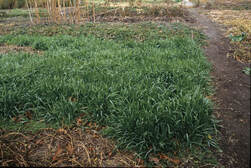 If there are areas of the garden that are done producing, chop and shred residue in preparation for tilling. If soils are wet, wait a few days so the soil is no longer muddy. Tilling in residue allows plant material to decompose and helps reduce insect and disease problems for the next year. Also consider using a cover crop to hold the soil and increase the organic matter content of the soil. Small gains such as wheat should be seeded at 3/4 to 1 pound of seed per 1,000 square feet from mid-September to late October. Spring oats can also be seeded until mid-September but the rate should be 2 to 4 pounds per 1,000 square feet. Spring oats will winter kill and can be tilled under in the spring. Legume cover crops such as hairy vetch, alfalfa and sweetclover provide an additional benefit by ‘fixing’ nitrogen, thereby increasing fertility of the soil. Each of these should be seeded at about 1/4 to ½ pound of seed per 1,000 square feet of garden. Sweetclover should be seeded during from August to early September and hairy vetch and alfalfa from mid-August to late September. (Ward Upham) 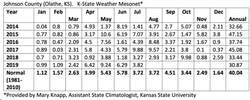 Declining Oaks...are not that easy to sort out. There is an assumption that if an oak tree is dying it must be due to a disease. That is usually NOT the case. Most of the poor growth that we see on oak trees in Kansas is generally due to a combination of site factors and environmental extremes. 2018 and 2019 provide back to back examples of weather extremes. Add in site factors like tree planting depth (too deep), construction damage, heavy soils or compacted soils that drain poorly, sandy soils that don’t hold on to water very well, and trees can develop root systems that are not as vigorous as they should be. The result is a situation where trees are prone to declining under weather extremes – and Kansas is all about extreme weather. A look at some weather data for Johnson County (Olathe, KS) provided by the K-State Weather Mesonet shows that the 20yr average annual precipitation is 40.04” for that location. At a glance it is easy to see that some years run wetter than average and some years are drier than average. I picked the Johnson County, KS location to highlight because we frequently get oak tree samples in the K-State Plant Disease Diagnostic Lab from the Kansas City area with questions about disease. 2018 was a dry year due to a winter drought and we saw trees decline across the state, including quite a few oaks from the Kansas City area. There was below average precipitation between November 2017 and September 2018. This weather snapshot also shows extreme weather during 2019, particularly during April and May. Saturated soils resulting in root damage and tree decline has been a common problem this year. Young trees and shrubs are particularly at risk due to smaller root systems. In many cases, damage wasn’t immediately apparent until June or July when higher temperatures put a greater demand on the root system. So bottom line, extreme weather patterns frequently play a role in the health of our landscapes. (Judy O’Mara) Editors Note: Judy also discusses two diseases found on oaks in Kansas in her original article, Hypoxylon Canker and Oak Wilt. See https://blogs.k-state.edu/turf/declining-oaks/ . 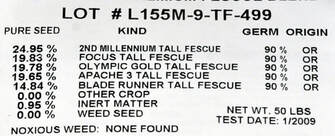 Fall planting time is close at hand, so it's time to talk about grass seed. Many people have the idea that all grass seed is basically the same. Big mistake! Choosing quality seed is one of the most important steps in successfully planting or overseeding your lawn. If you don't know what to look for, you may be introducing unwanted intruders into that new stand. In particular, we are concerned with seed contaminated with orchardgrass and/or rough bluegrass (also known by its Latin name, Poa trivialis, or Poa triv for short). These are both perennial grassy weeds that cannot be selectively controlled once they are in a lawn. Orchardgrass is a problem because it is faster growing and lighter green than our turfgrasses. It is a bunch grass and so doesn’t spread, but infested areas are still unsightly due to small tufts of this species pockmarking the lawn. Rough bluegrass is fine-textured and forms circular patches in the lawn. It blends in fairly well until summertime heat causes it to turn brown rapidly. If the rough bluegrass would just die in the heat, it would only be a temporary problem. Unfortunately, it usually just goes dormant, turning green again with cooler temperatures and rain. Buying quality seed starts with knowing how to decipher the seed label. One of the most important things to look for is listed as percent "Other Crop Seed” or “Other Crop.” "Other crop" refers to any species that is intentionally grown for some purpose. That would include turfgrasses (those species other than the one you are buying) and pasture grasses. Orchardgrass and rough bluegrass both are listed as “Other Crop” seed. Seed labels are required by law to show the percentage (by weight) of "Other Crop Seed" in the bag, but unless a species constitutes 5% or more, the label doesn't have to list each species by name. How much "Other Crop" is too much? That’s a difficult question to answer, but the tolerance is very low. It depends on what the "Other Crop" actually is, and the quality expectations of the buyer. In practice, "Other Crop" may refer to something relatively harmless, like a small amount of perennial ryegrass in a bag of tall fescue, or it may refer to something bad, like rough bluegrass or orchardgrass. The homeowner really has no easy way of knowing what the "Other Crop" is, although there are some hints. If it is something bad, less than ½ of 1% can ruin a bag of seed. Obviously, if your expectations are high for the area you are planting, you would want the "Other Crop" to be as close to zero as possible. Good quality seed will often have 0.01% “Other Crop Seed” or less. Another line on the seed label is “Weed Seed.” It should also be 0.01% or less. (Ward Upham) |
AuthorsCynthia Domenghini runs the Horticulture Response Center in the Department of Horticulture and Natural Resources at Kansas State University. Other contributors include K-State Extension Specialists. Archives
March 2024
Categories
All
|
| K-State Research and Extension Horticulture Newsletter |
|
 RSS Feed
RSS Feed
